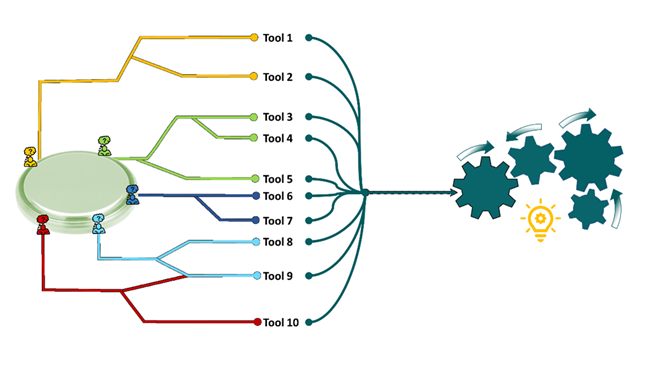BIG-MAP has developed a methodology to coordinate multi-site, multi-partners and multi-techniques investigations on standardized battery materials and cells using an array of complementary tools both in-lab and at large scale facilities. This multimodal characterization platform enables an optimized access to multidimensional parameter mapping. Specific workflows were designed and operated to combine experimental tools and acquire complementary sets of data with established fidelity criteria, paving the way to automatized correlative characterization.

Battery materials or cells can be characterized by a wealth of lab-scale and large-scale facility techniques, e.g., for instance, spectroscopies, imaging or diffraction, in many different types of modalities, e.g., low resolution fast-scanning or high resolution, post-mortem or operando, surface or bulk, etc. Each of these techniques may provide key insights into one specific aspect of materials and interfaces behaviors. However, data acquired on different instruments by different teams are usually not comparable or jointly exploitable, as they are not obtained in the same conditions with the same time or space resolutions, and not accompanied by the appropriate ontologized metadata. The single-technique approach has long lived but does not allow to accelerate our understanding of the complexity of battery processes, as well as to establish a more holistic knowledge of what governs the battery behavior, coupled to multiscale modelling, digital and AI enhanced approaches.
BIG-MAP is overcoming these hurdles by coordinating and correlating experiments to accelerate and automatize multiscale characterization. The first task was to list the characterisation experiments available in the consortium together with their technical and logistical characteristics (resolution, energy, observable, delay for measurement, characterisation readiness level CRL, etc.). The matrix regroups 136 available characterisation experiments each described with 27 descriptors, and it is available here. Based on the matrix information, we designed and executed an archetypal experimental workflow involving several facilities across Europe. As a result, pan-European in-lab and Large Scale Facility (LSF) characterization experiments were performed on a selected chemistry (graphite/LNO) probing a large range of temporal and spatial domains with various degrees of data fidelity. Data were stored on the BIG-MAP Archive, with metadata included in the BIG-MAP Notebook and linked to the BattINFO ontology. Samples were centrally produced in a standardized way and cells cycled using standardized protocols. In 18 months, more than 50 Tier-2 experiments were performed on fresh and aged materials using standard and modified electrolytes produced within BIG-MAP, and all extracted parameters were classified to allow for inputs into AI and modelling activities.
BIG-MAP is making an important step toward multiscale correlative characterization, setting the foundations for automated workflow-constructors available through ontology-based applications.